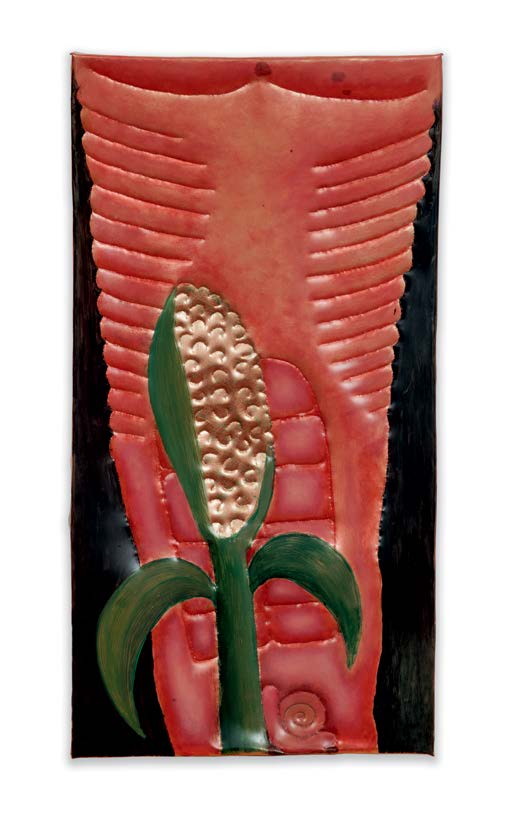experimented with unusual grounds, applying oil paint to substrates
such as felt, plaster, ceramic, and board. He has embraced a surrealist
sensibility of fragmented objects, disjunctive interior spaces, mundane
objects, fruits and vegetables, and bodily references replete with genitalia.
After moving to the Western Catskills in New York state during
Covid, de Paoli discovered a kind of flashing material—thin copper
on a roll, approximately 11 inches wide—which he transformed into
a new substrate material of hand-formed, slightly irregular panels of
copper, onto which he would paint. Inspired by the new materials,
motifs, surroundings, and experiences of his rural residence in upstate
New York, de Paoli has produced a new body of work of oil-on-copper
paintings that were first presented in his exhibition Inside the Red Barn
at OSMOS Station in Stamford, New York. The smooth and reflective
copper supports, sourced by de Paoli from a local building supply
store, are reminiscent of a 17th Century painting the artist first saw in
a Paris museum, and which has ever since fascinated de Paoli for both
its luminosity and oddity.
The exhibition opens with a slightly wonky rectangular object on
the wall, entitled In the Field (2022). This small oil-on-copper painting
presents a close look at a piece of corn, which is rendered as a luminous
relief, driven into the pure copper as outline and volume, while the
surrounding night scene is painted and oddly mute. Striated lines in
the conical, muted red background are reminiscent of a ribcage or a
carcass, while a silhouetted snail (a frequent occurrence in de Paoli’s
surreal menagerie of animal protagonists) attempts to mount the corn
stalk from the bottom right edge of the painting. The same snail form
makes an appearance in the painting directly across from In the Field.
A diptych of hand-formed copper panels, the painting Going Up (2022)
presents a table-top still life of three forms—two vase-like, tall, and
erect shapes and a heart-shaped, slightly vaginal form on the left side
of the table. At the bottom, a snail caught in mid-climb up the right
table leg mirrors the shape and placement of the snail in the painting
In the Field. In the bottom center of the painting, a painted penis,
replete with two scrotums, oddly mirrors the shape and position of
the snail.
Several smaller paintings feature details from the artist’s immediate
environment, such as Red Window (2022), which refers to the artist’s
studio with its crimson walls, carpet, doors, and windows, while Blue
Meadow (2022), a delicate triptych of lightly curved copper sheets,
captures the view from the artist’s office as an imagined brown knoll
under a bright blue sky densely populated by bright, copper clouds.
Two paintings on felt connect the new work to de Paoli’s previous
oeuvre: Morning Clouds (2021) presents a low, rolling cloud of morning
fog over a brown, ragged field, crowned by an oddly blue sky with
a yellow curved, almost breast-like cleavage in the center. A thick line
of solid paint, dissecting the low cloud like a scar or a fissure, is meant
to be read, according to de Paoli, as a line of cocaine—further proof
of the artist’s unique, surreal (and slightly dangerous) sensibility. The
second oil-on-felt painting, Warbird (2022), is even stranger. A central form, shaped like a winged whale or fish-like airplane, has two hotdogs as rockets
or jet propulsion engines, and a fried egg as a hovering control center or a cloud
of anti-missile countermeasures hovering above. Clearly flying above a densely
crenellated cloudscape, the titular warbird seems to rather enjoy the view.
The centerpiece of the exhibition is a multi-panel oil-on-copper painting that
the artist describes as “an altarpiece for Stamford.” Comprised of nine vertical
sections—each containing a tall upper and square lower panel—the polyptych
borrows from the visual logic of the altar pieces of the Trecento that served as de
Paoli’s inspiration (think Duccio and Giotto), with their narratives dispersed across
a central panel, wings, and predella while still preserving the gilded ground of
earlier pictorial conventions. Here, each upper segment features a variation on the
same repeating motif—a priapic shape of two round fields connected by a central
“neck” that ends at the bottom in two additional spherical forms. The overall form
paradoxically evokes both the suggestion of a phallic shape and the torso of a
woman with her breasts exposed. Each figure is crowned by a round segment of
exposed copper reminiscent of a halo or mandorla. The bottom panels, much like
Renaissance predellas, present a continuous still-life scene of apples and plates on
a suggested tabletop. In equal parts surrealist devotional painting, still life
painting of upstate New York’s most iconic fruit, and material experiment, the
monumental work is one of de Paoli’s most ambitious and masterful creations to date.
Together, these works represent a powerful evolution of and departure from de
Paoli’s earlier works and can be understood as a celebration of the artist’s new
surroundings in the Western Catskills, an area that for the Hudson River School
painters and poets such as William Cullen Bryant represented a new kind of spiritual
edifice, a “cathedral of nature,” for which de Paoli created his spectacular
altarpiece.
- Choosing a selection results in a full page refresh.
- Opens in a new window.




